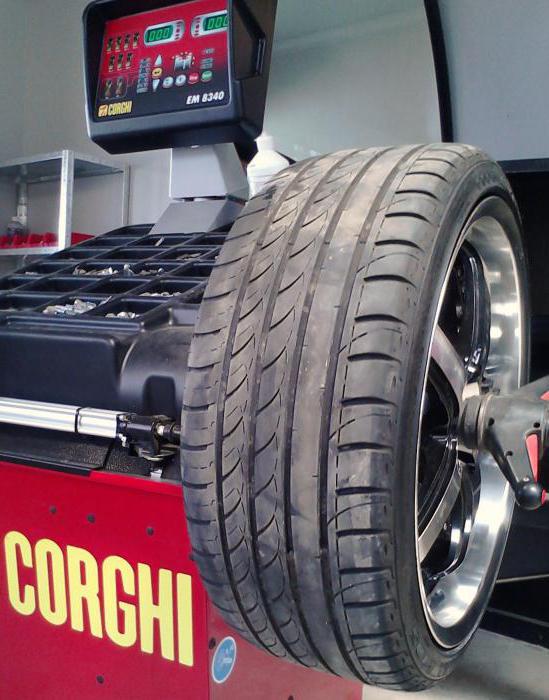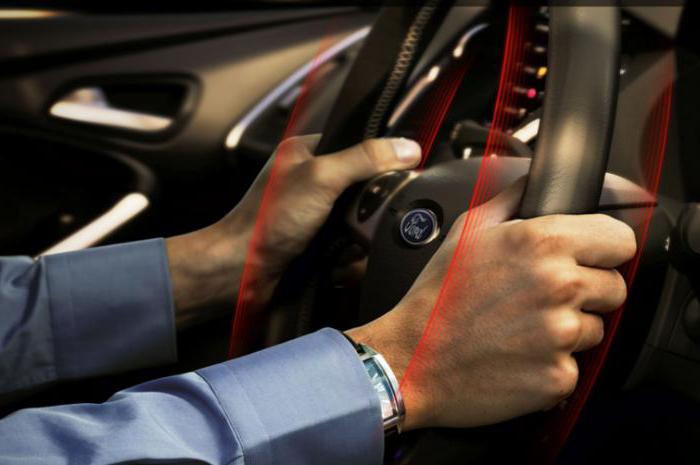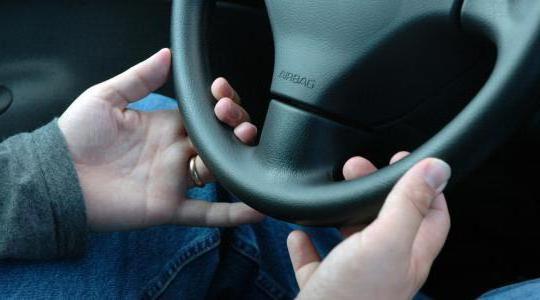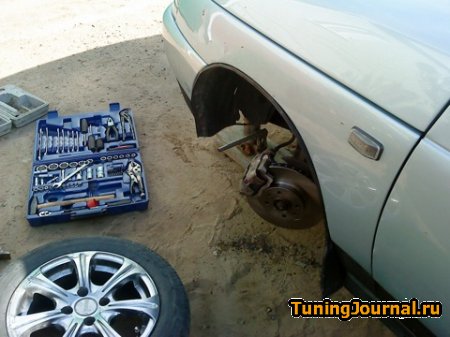Wheel vibration when driving on a flat road. Blog › Steering wheel runout: causes and solutions
Steering wheel vibration is one of the most irritating and unpleasant factors when operating a car. In addition, it can not only infuriate any driver, but even in some cases, beating on the steering wheel becomes the reason for creating an emergency situation.
Vibration on the steering wheel can be of two types:
- Vibration at speed;
- Vibration when braking.
The sources of occurrence of these two types of vibration are different, as is its very nature.
The problem associated with steering wheel vibration at speed (or when driving) quite often appears among car owners after seasonal change tires, as well as due to hitting a hole at speed. Moreover, the runout can be either constant or occurring at a certain speed (mostly from 80 km to 100 km/h), although there are cases when the runout cannot be analyzed when it begins at different speeds and different road surfaces.
You can wonder for a long time what the problem is, but one thing is clear, in most cases it is an imbalance in the mass of one or several wheels or deformation of the disks after a hole is caught. Let's consider these and other reasons, which, as a rule, also complement each other.
Causes of steering wheel beating at speed
▪ Dirty disk;
▪ Wheel balancing is impaired;
▪ Violation of tire or disk geometry;
▪ Deformation of the hub or the entire suspension (mainly a violation of the parameters of the levers);
▪ The disc does not correspond to the parameters of the hub (the wheel alignment is incorrect). This reason also includes improper tightening of the wheel bolts, which have a conical base. The nuts must be tightened manually with the wheel suspended, alternating the sequence of opposite bolts.
There is only one conclusion from all that has been said: you need to do balancing at trusted service stations, monitor the condition of the rims and tires, and drive the car carefully. Produce correct installation tires and wheels in accordance with technical specifications. characteristics.
The problem with steering wheel vibration when braking is either the wheel rims or the brake pads. An accurate diagnosis can only be made by disassembling the caliper and checking the condition of the pads and brake discs. Broken steering rods and play in the steering rack also have a similar effect.
Causes of steering wheel beating when braking
▪ The brake pads are worn to zero;
▪ Lamination of pads;
▪ Development of the brake disc;
▪ Violation of the geometry of the disc or brake drum;
▪ The brake caliper is not functioning correctly (the guides are jammed, the piston is not working properly);
▪ Steering rods and steering.
From all of the above, we conclude that the cure for beating in the steering wheel when braking is a high-quality overhaul of the brake mechanism, both front and rear. Timely replacement of brake pads, brake discs and maintenance of calipers. The rack has significant play.
A long road tires everyone, and even more so the driver. Many drivers have encountered such a situation as the steering wheel beating at speed, which lasts for a long time. It is worth noting that car vibration can be natural, and there is no reason to worry. Such cases include uneven road surfaces. In other cases, on a flat surface, the presence of extraneous vibrations is an alarm bell indicating a malfunction.
If you ignore the appearance of vibration, then you can seriously pay in the future not only with expensive repairs. During moments of vibration, special attention is paid to the steering wheel and its imbalance. Most often, steering wheel wobble at speed occurs due to lack of wheel balance, but this is not the only reason. There are many reasons for steering wheel vibration, to determine which it is necessary to test the car on the track, periodically switching from one gear to another.
The main causes of steering wheel vibration
When knocking sounds appear on the steering wheel, remember the speed at which it happened. Then you should diagnose the car while driving and set a speed limit at which the vibration disappears. Very often, beating occurs while driving at low speeds and at medium speeds, while the steering wheel shakes quite unpleasantly. But if the driver increases the speed a little, the vibration ceases to appear. It may reappear during sudden acceleration. When testing your car, you should look at the appearance of shaking during hard braking or acceleration. It is necessary to view the vibration strength during diagnosis. The reasons for steering wheel wobble at speed are varied.
Improper balancing due to foreign substances
The most common cause of beating on the steering wheel is the presence of foreign substances on the inside rim. This is why the wheels become unbalanced, causing the car to vibrate on the highway at different speeds. If there is dirt on the discs and the road is uneven, then after a while the beating may stop due to the spontaneous falling off of lumps of dirt. However, if there are knocking noises, it is better to stop and look at the discs. If there is dirt, it is better to remove it using a special metal brush. The easiest way to determine its presence is alloy wheels, but on stamped wheels such an inspection without removal will be very difficult. In this case, you will need an overpass or a lift. Snow also affects the wheels in the same way, clogging the discs on the inside as tightly as possible, which affects vibration.
Lack of wheel balancing
Wheel rims are manufactured to be uneven in shape and composition, resulting in different weights being applied to each area. The center is pulled in the direction where the greatest mass is located. As soon as the center shifts, the centrifugal force also shifts. As a result, a beating occurs in the steering wheel at speed due to the existing transmitted forces along the chain of rods on high speed.  That is why it is necessary to balance the wheels after each tire or wheel change. Balancing is a process in which the mass of the wheel is equalized along the entire contour using special elements, popularly called “weights.” They are glued or hammered onto the wheel rim from the inside.
That is why it is necessary to balance the wheels after each tire or wheel change. Balancing is a process in which the mass of the wheel is equalized along the entire contour using special elements, popularly called “weights.” They are glued or hammered onto the wheel rim from the inside.
Natural tire wear
During long-term use vehicle Improperly balanced wheels will cause rapid movement at some points, which will subsequently lead to severe vibration. In addition to rubber wear, the pressure on the hub bearing and some suspension elements will increase during operation, which will increase the beating on the steering wheel at speed.  It is quite easy to determine if the balance is out of balance. When driving at high speeds, slight vibration occurs. Using the example passenger cars the speed must be at least 60 km/h. Visually, the wheels will be intact, there will be no signs of deformation on the tires and disks.
It is quite easy to determine if the balance is out of balance. When driving at high speeds, slight vibration occurs. Using the example passenger cars the speed must be at least 60 km/h. Visually, the wheels will be intact, there will be no signs of deformation on the tires and disks.
Wheel deformation
The degree of its development has a strong influence on the presence of vibration. Wheel deformation occurs when a disc hits a hole at high speed. The curvature of the wheel can be determined by visual inspection: if the disk has fallen into a hole and is deformed in some places, dents will be observed on the wheel rim. In most cases, the front side of the disc is deformed less often than the inner side. Among cast and steel wheels, deformation is inherent in the latter. Sometimes the disc is crooked from the moment it was purchased. You can check its curvature on a special wheel balancing stand, which is available in any tire shop. If the wheel moves in a figure eight, this will indicate the presence of severe deformation or curvature from the moment of manufacture. Because of this, vibration occurs not only in the steering wheel. It is transmitted throughout the suspension, and then spreads throughout the body.  When using worn or deformed tires, steering wheel wobble will be observed at a speed of 120 km/h. In this case, there may be not only beating of the steering wheel, but also vibration of the machine, which depends on the degree of wear. The only way out of this situation is to completely replace the wheels or tires.
When using worn or deformed tires, steering wheel wobble will be observed at a speed of 120 km/h. In this case, there may be not only beating of the steering wheel, but also vibration of the machine, which depends on the degree of wear. The only way out of this situation is to completely replace the wheels or tires.
Insufficient tire pressure
If there is insufficient pressure in the wheels, then vibration will begin to occur throughout the vehicle (less often it transfers to the steering wheel). By inflating your tires, you can solve existing vibration problems.
Weak wheel fastening
Steering wheel wobble at low speed can be observed when the disks are loosely fastened to the hub. If strong vibration occurs when starting to move, you must stop immediately and visually inspect the mounting bolts.  As a rule, some of them can be easily rotated by hand. However, if they do not turn, you need to take a wheel wrench and tighten the bolts. Otherwise, ignoring the situation will result in the wheel simply unscrewing from the drum, which can cause an accident. At low speeds this will not be so dangerous, but still you should not bring the car to this state. An acyclic, that is, inconsistent beating of the steering wheel at different speeds, may also be observed.
As a rule, some of them can be easily rotated by hand. However, if they do not turn, you need to take a wheel wrench and tighten the bolts. Otherwise, ignoring the situation will result in the wheel simply unscrewing from the drum, which can cause an accident. At low speeds this will not be so dangerous, but still you should not bring the car to this state. An acyclic, that is, inconsistent beating of the steering wheel at different speeds, may also be observed.
Malfunction of the suspension or steering system
There are other reasons for which the steering wheel wobbles at speed due to untimely vehicle maintenance. A malfunctioning suspension greatly affects the car's grip on the road. If there is play in the suspension or steering system elements, the same vibrations will occur during turning as when using bent wheels. This reason is indirect.
Steering wheel wobble when braking at speed
This is a very serious malfunction. If there is a wobble in the steering wheel at high speed when braking, this is the main sign of wear on the brake discs. This indicates that the discs or drums have signs of deformation, that is, the surface will be wavy. It can be caused by a long service life or overheating of the drum or disk during sudden braking.  If a drum or disc is deformed, vibration will only be observed during braking, when the pads are pressed onto the disc. The problem can be solved only by replacing these elements with new ones.
If a drum or disc is deformed, vibration will only be observed during braking, when the pads are pressed onto the disc. The problem can be solved only by replacing these elements with new ones.
Steering wheel wobble when turning
When driving, vibration on the steering wheel at speed can also occur during turns. In this case, you can safely declare the need for diagnostics and subsequent replacement of the suspension, since the CV joint or silent block has failed. When turning, in addition to shaking, you will hear a characteristic crunch from under the wheels. During this process, it is necessary to check the functionality of the hub bearing and, if large wear is detected, replace it. To prevent vibration when turning, you need to carry out periodic inspections at a service station. When independently inspecting a car in a pit, the first sign of impending vibration is a crackling sound on the boots. They should be replaced with lubricant.  When driving on an uneven road, beating indicates a malfunction of the steering rack. The lever bushing may fail. A failed shock absorber also affects the steering wheel's beating. Thus, there are many reasons why the steering wheel shakes while driving. In each case, the first step is to carry out a visual inspection and eliminate the malfunction.
When driving on an uneven road, beating indicates a malfunction of the steering rack. The lever bushing may fail. A failed shock absorber also affects the steering wheel's beating. Thus, there are many reasons why the steering wheel shakes while driving. In each case, the first step is to carry out a visual inspection and eliminate the malfunction.
So, we found out the reason for the steering wheel beating at high speed and when braking.
A problem that has become widespread is that the steering wheel shakes at low speeds or when braking. What is the problem with such an unpleasant phenomenon that makes the driver panic?
Newbies panic, count money and wait for news from their auto mechanic. But is it worth worrying about this problem, is it possible to solve it yourself and how much will it cost if you contact a service center?
The steering wheel shakes at low speed, this is already in a critical situation, when a breakdown in the steering mechanism has already occurred. If you notice a similar phenomenon at low speed or when braking, then you should think about it. Continued use of the vehicle may result in even more expensive repairs.

Case from practice
The owner began to notice a similar phenomenon; extraneous vibrations appeared in the steering mechanism when the car was moving in the area 70 km/h. If the speed was insignificant, vibrations disappeared, and after accelerating the car over 100 km/h, they were also not observed.
Taking into account the quality of our roads (which is poor), and plus the vibrations and beatings that a faulty steering mechanism creates, driving such a car turned into torture. The steering wheel just almost jumped out of my hands.
Naturally, the most effective and simplest way is drive the car to the station maintenance . But it’s good if you have a familiar auto mechanic who will do everything efficiently. What if not? Then few people will give you a guarantee that the car will be repaired quickly, and the money that will be collected from you will be comparable to repairs.
Yes, such a problem occurs quite often; auto mechanics constantly make money from such troubles, increasing the cost of repairs. They may also impose costs on you for unnecessary manipulations, for example, replacing the entire steering mechanism, because few people want to dig around and look for the real causes of the malfunction. To prevent this from happening, any car owner should at least roughly know the reasons for this behavior of the steering wheel.

Reasons
Your wheels may need balancing. Yes, an unbalanced wheel can create unpleasant vibrations throughout the body, transmitting them to the steering wheel. Visit a tire shop, where a mechanic will use a special device to do it if necessary. If after such a repair the beating does not go away, we look for the problem in another place.
Brake pads need to be checked on the front wheels. If they are worn enough to require replacement, the steering wheel may start to wobble. Moreover, brake pads on all cars are consumables, and this element must be replaced after a certain amount of mileage. Keep an eye on this.
Have you replaced your brake pads and the runout hasn't stopped? Then it follows. There should be no play in them; to check this, ask an assistant to hold the steering wheel while you pull the steering rods on both sides (to do this, you must first raise the car with a jack).
As in any living organism, all car systems are interconnected and constantly functioning. For this reason, a breakdown or defect in one part can lead to the improper functioning of another part of the car or even a group.
How does it manifest itself?
For those who neglect periodic vehicle diagnostics, drivers with little experience, it will be very useful to read this article.We're talking about the steering wheel beating at speed. Moreover, this vibration can occur both when the car moves quickly and when it is quite slow. Sometimes this happens even when braking or turning. Let's look at everything in order.
The first type is steering wheel beating at speed. Sometimes it occurs after the car has gone over 100 km/h, sometimes 40-50 km/h is enough for a problem to occur. I would like to draw your attention to the fact that you should not take steering wheel vibration at low speeds any less seriously than at high speeds.
Possible reasons
There may be several reasons.Firstly, the geometry of the disc may be disrupted. To clarify the problem, you should contact a tire repair shop. The problem can be both a manufacturing defect and our ugly roads. Also, unpleasant shocks can be caused by a bump on the tire or improper repair of the disc.
If runout occurs at low speed, things can become more serious. A broken steering rod or suspension can lead to this result.
There is a possibility that your wheels are not balanced correctly. To fix the problem you will need a stand.

Even the most ordinary dirt that has accumulated on the inside of the disk can cause a similar effect. This is more likely during colder times of the year as the dirt can become very frozen.
A similar problem can arise even after replacing the wheel rims with new ones that do not correspond to the standard dimensions of the hub.
Possible options When driving the car on a flat road, we have looked at the manifestation of this problem on bumpy terrain.
Pressure is also an indicator
You should immediately turn your attention to the air pressure in the wheels. If it is not the same, there may be a problem.Be sure to check the serviceability of the steering rack, start the process with the bushing.
Don't forget about shock absorbers. If the front suspension has faulty shock absorbers, then most likely the problem is due to them.
Steering wheel wobble when cornering is almost always caused by failure of CV joints or silent blocks. In this case, only replacing these elements will help you out.






